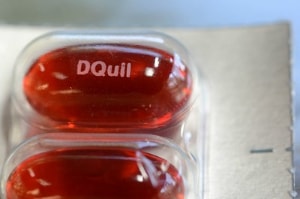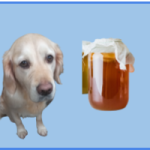What happens when your dog eats a DayQuil? You know, like in the case of this 4-month old Golden Retriever. He was probably curious and thought it was a treat. You know, like puppies do. What do you do? Is it safe? Like, will he get a bit queasy and then get over it, or should you be worried?
Or, what if your dog gets the flu? Is it okay to give him human flu meds, or should you stick to those tried and trusted home remedies?
Let’s find out.
What is DayQuil? What are the active ingredients?
DayQuil is a flu remedy that combats those pesky flu symptoms without leaving you all drowsy and incapacitated. The idea is that you can carry on with your normal daily activities while still recovering from a cold or flu.
The active ingredients in DayQuil are acetaminophen, dextromethorphan, and phenylephrine. Say what, now? Okay, for us ordinary people, these complicated-sounding names do the following:
Acetaminophen relieves fever and pain. While it doesn’t actually take the pain away, it interferes with how your body senses the pain. Basically, it tells your brain, “no, you’re not feeling pain,” and your brain believes it. Viola! Then, it also helps your body regulate its temperature, so that fever can go away.
Dextromethorphan stops the cough by suppressing the urge to cough. So, you still have all that slimy gunk in your system, but you’re not coughing your lungs out, so they can have a break.
Phenylephrine is a non-drowsy nasal decongestant. This bad boy reduces the swelling in your nasal passage blood vessels, helping you to (literally) breathe a sigh of relief.
What are other similar products to DayQuil?
There are many over-the-counter (OTC) flu meds on the market, so you won’t search far for an alternative. NyQuil is the closest to DayQuil. It’s basically the same product but with a different nasal decongestant. Spoiler alert: NyQuil causes drowsiness, while DayQuil doesn’t.
Vicks Sinex is an alternative non-drowsy OTC flu med. It works similar to DayQuil and kicks in pretty fast. Then there’s Mucinex, which is suitable for day-time use. You know, so you won’t fall asleep at your desk. Although you’re ill enough to warrant meds, it’s probably a good idea to stay in bed anyway. That way, you heal faster, and you don’t infect your co-workers or the lady at the corner shop.
Is DayQuil toxic to dogs?
Guys, human medication isn’t meant for our four-footed kids. Seriously.
Acetaminophen, the main ingredient in most cold and flu medication, is toxic for cats and can be poisonous for dogs, too. While this is a super-duper drug for humans, it causes liver damage for our fur kids and damages the red blood cells. These are meant to carry oxygen, so damaging them causes severe complications for our pups.
Phenylephrine, the nasal decongestant, is the culprit causing those heart palpitations when we take flu meds. It does the same to our pets, only worse. This causes blood pressure issues and cardiac arrhythmia, which could be very serious.
Dog ate DayQuil. What should you do?
Your dog found the flu tablets you left on the counter in your flu-induced semi-coma. Now he’s freaking out, you’re freaking out, and no one knows what to do. Calm down. We’re here to help.
If you have a Yorkie or similar small breed dog, rush him to the vet immediately. With any luck, the vet manages to induce vomiting and limit the potential damage. Once he’s vomited out whatever he ate, his stomach can’t absorb any more of the harmful ingredients.
If you have a large dog, anything over 5kg (11 lbs), he should be fine unless he ate the entire container. If this happened, rush him to the vet too.
While there isn’t a specific antidote to the active ingredients in DayQuil, there are things that the vet can administer to your dog to minimize the DayQuil side effects. These include Mucomyst or Acetadote, antioxidants like Vitamin C, and liver protectants like milk thistle.
There is a clinical test to determine whether your dog ingested acetaminophen, one of the active ingredients in DayQuil. However, this is hardly ever used since the test is usually only carried out at human hospitals and takes too long. Your pup needs treatment right away, so waiting for the test results would take way too long.
What are the side effects of Dayquil poisoning?
When your dog ingests acetaminophen, he could develop facial swelling, vomit, stop eating, and his gums could become discolored. He could also show signs of lethargy, have difficulty breathing, collapse into a coma, have dry eyes, and have dark urine. This is scary stuff, guys.
Phenylephrine, the decongestant, sends your fur kid’s heart racing in hyperdrive. That’s not good.
How quickly will Dayquil work?
In humans, DayQuil takes about 30 minutes to kick in. Now, we’re quite a lot bigger than our fur kids, and their metabolism tends to be way faster than ours. So, in short, DayQuil will kick in within 30 minutes of your dog taking it, max.
How long will the effects last?
DayQuil offers relief from cold and flu symptoms for 4 to 8 hours. For humans, at least. If your dog chomped away at your DayQuil, the side effects could blow over quickly, or it could hang around for a really long time, depending on a whole host of factors.
If you have a large dog, he only ate one DayQuil, and you managed to induce vomiting really quickly, he’ll probably be fine within a few hours. On the other hand, if your pup ingested a large dose of the stuff and didn’t cough it up in time, he could suffer permanent damage to his liver. That is if he survives the ordeal.
So, in short, it depends. It’s best to keep the stuff away from your pup, just to be sure.
Is there a dog-safe or home remedy alternative to DayQuil?
So, dogs can also get the flu, and they need treatment to feel better, just like we do. We now know that human flu meds are not safe for pups, so what do we do? Luckily, there are tons of home remedies available to get your pup up and at it again.
Side note: if your dog has flu symptoms, it could indicate that something more serious is afoot, like kennel cough. So, when your dog looks a bit flu-y, have him checked out by the vet. Rather err on the side of caution.
Your grandmother was right. Chicken soup beats the flu every time! This holds true for dogs as well. When your pup’s under the weather, whip up some lukewarm, low sodium chicken soup for him.
Steaming your home is another sure-fire way to help your pup on the road to health. Steam opens up the bronchial passages, easing your fur kid’s breathing difficulties. If you don’t have a humidifier, run hot water in the shower or bath, letting the place mist up properly. Then, take your pup in there for about ten minutes, soaking up that moist air. Alternatively, you could use a vaporizer, like the Vicks Warm Mist Humidifier in a small room. Heck, you could even add some essential oils to the mix if you want. Just don’t leave your pooch alone with the stuff. We all know how much they like sniffing and licking new things.
How to store Dayquil safely?
This one is a no-brainer. Lock the stuff up where dogs and kids can’t get to it. Medication isn’t toys or sweets and shouldn’t ever be placed in a space where kids or dogs could mistake them for it. Don’t leave the meds in your coat pockets or handbag since your dog could come sniffing here for treats.
Closing Thoughts
While DayQuil works wonders for humans, it’s downright poisonous for dogs. If your dog gets his paws on the stuff, take him to the vet immediately, especially if it’s a small dog—the smaller the dog, the more severe the effects. Your vet will induce vomiting and probably administer vitamins to help your dog’s body cope with the effects. It’s always safer to keep your meds locked away where your dog can’t find them.
If your dog is a bit under the weather and you suspect that he has doggy flu, offer him some chicken soup or other home remedies, not human flu meds.






